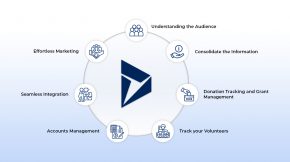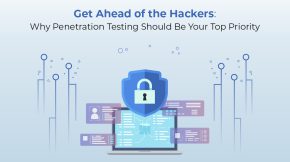How to Prevent Cyber Attacks? Here are 10 Ways
10 Best Ways to Protect Business from Cyber Attacks
Cyber-attacks pose a major threat to businesses of all sizes. A single breach can result in massive financial losses, lawsuits, and permanent damage to a company’s reputation. Recent high-profile cyber-attacks like the SolarWinds and Colonial Pipeline hacks demonstrate how vulnerable even large enterprises are to cybercrime.
The average cost of a data breach has risen to $4.35 million in 2022. With attacks becoming more frequent and sophisticated, no business can afford to neglect cybersecurity. Implementing robust measures on how to prevent cyber attacks is essential. Here are 10 ways to protect your computer from hackers and ensure effective cyber attack prevention:
1. Train Employees on Cybersecurity Best Practices
One of the most common ways cybercriminals gain access is by exploiting human error. Phishing emails impersonating executives or vendors trick employees into handing over login credentials or sensitive data. Company devices infected with malware provide a backdoor for hackers to steal files and install ransomware.
Comprehensive cybersecurity training makes employees the first line of defense. Teach best practices like identifying phishing attempts, using strong passwords, securing devices when working remotely, and reporting suspicious activity. Role-based training ensures employees understand the cyber risks associated with their position and how to prevent cyber attacks.
2. Install and Constantly Update Antivirus Software
Antivirus software detects and blocks known malware threats like viruses, worms, spyware, and ransomware. But it relies on frequently updated virus definitions to identify new threats.
Failing to update antivirus software leaves computers vulnerable to zero-day attacks using new strains of malware. Automate the update process so virus definitions update daily without administrator involvement. Cloud-based antivirus solutions offer superior protection and easier management since all devices connect to the cloud console to retrieve updates. Antivirus software is crucial on how to prevent cyber theft and how to protect yourself from cyber attacks.
3. Use a Firewall
Firewalls filter incoming and outgoing network traffic based on a defined set of security rules. They prevent cybercriminals from probing systems for vulnerabilities or using malware to communicate with compromised devices.
Hardware and software firewall solutions are available. While both have the same goal of blocking unauthorized access, hardware firewalls tend to offer better performance and more configuration options. Firewalls are essential for effective cyber threat prevention.
4. Enforce Strong Password Policies
Weak passwords are behind 81% of hacking-related breaches according to Verizon’s 2022 Data Breach Investigations Report.
Enforce password policies requiring a minimum 12 character length, a mix of upper/lowercase letters, numbers and symbols, no reuse of old passwords, and changes every 90 days. For added security, implement multi-factor authentication (MFA), which requires employees to provide two or more credentials in addition to a password when logging in. Strong password policies are one of the ways on how to prevent cyber attacks.
Regularly monitoring systems for suspicious activity is another important aspect of cyber attack prevention. Implement tools that alert IT staff to anomalies like large data transfers, logins from unfamiliar locations, or attempted access to restricted files. The sooner a potential breach is identified, the faster it can be contained to minimize damage. Proactive monitoring helps businesses on how to prepare for a cyber attack and respond quickly if one occurs.
Secure Remote Access
The shift to remote work due to the pandemic significantly increased cybersecurity risks. Employees accessing networks from home devices expands the attack surface.
Mandate use of a virtual private network (VPN) for secure remote access over the internet. A VPN encrypts data in transit to prevent eavesdropping or tampering. Thus helps answer how to prevent cyber attacks.
Limit access to only necessary applications and resources based on user roles. Monitoring tools like cloud access security brokers (CASBs) provide visibility into risky user behavior indicative of a compromised account. Securing remote access is crucial on how to prevent cyber attacks and protect yourself from cyber attacks.
5. Regularly Patch Software
Cybercriminals continuously scan the internet for vulnerable, outdated software to exploit. Failing to promptly install patches for known vulnerabilities leaves you open to attacks.
Prioritize patching based on severity scores like CVSS to fix the most dangerous flaws first. Automate patching processes using tools like Microsoft Endpoint Configuration Manager to ensure devices stay updated.
The WannaCry ransomware outbreak that disrupted over 200,000 computers across 150 countries in 2017 exploited a two-month-old vulnerability that should have been patched. Regular patching is one of the ways on how to prepare for a cyber attack and ensure effective cyber attack prevention.
6. Backup Critical Data
No prevention plan eliminates all cybersecurity risk. You still need ways to quickly recover should an attack occur.
Daily automated backups ensure access to recent versions of critical data should ransomware lock files or a disaster wipe out servers. Secure backups to a disaster recovery site or cloud storage where they can’t be accessed from the corporate network.
Test restoring from backups regularly to verify their integrity and usability when needed urgently. Backing up data is essential to understand on how to prepare for a cyber attack and minimize downtime.
7. Secure IoT Devices
Cameras, smart speakers, HVAC systems, medical devices, and more – the average office is filled with internet-connected IoT devices. Unfortunately, IoT security is often an afterthought, putting networks at risk.
Change default credentials that come preset on devices to unique passwords. Disable any unnecessary services that aren’t being used. Install updates pushing critical security patches.
Isolate IoT devices from the rest of the network using segmentation measures like VLANs to limit an infection’s blast radius should one become compromised. Securing IoT devices is a key aspect of cyber threat prevention and helps to understand how to prevent cyber attacks.
8. Consider Cyber Insurance
Despite best efforts, some attacks inevitably slip through. Cyber insurance cushions the financial blow of paying regulatory fines, customer breach notifications, legal fees, ransomware extortion demands, and lost revenue during recovery.
The premium costs are reasonable relative to the scale of damages a serious breach can cause. Between 20% to 30% of small and mid-sized businesses now carry cyber insurance policies. Cyber insurance is an important way on how to prepare for a cyber attack and mitigate financial losses.
9. Seek Outside Help Securing Critical Systems
Most small and mid-sized businesses can’t realistically employ a full in-house cybersecurity team. Nor do they have the scale or security expertise of large enterprises.
Seeking help from a managed security services provider (MSSP) cost-effectively strengthens defenses. MSSPs monitor networks 24/7 using advanced threat detection capabilities like security information and event management (SIEM) tools. They quickly identify and respond to incidents most companies would never catch on their own. Partnering with an MSSP is one of the most effective ways on how to prevent cyber attacks and ensure robust cyber attack prevention.
Implementing these 10 ways to protect your computer from hackers significantly reduces the risk of falling victim to a devastating cyber-attack. However, cybersecurity is an ongoing process, not a one-time event. As new threats emerge, businesses must continually adapt their defenses to stay ahead of cybercriminals. Regularly reviewing and updating security policies, procedures, and technologies is essential to maintain a strong security posture over time.
Protect Your Business with Help from the Experts at Beyond Key
Implementing cybersecurity best practices reduces risk but takes knowledge and effort many businesses lack. Beyond Key’s highly trained cybersecurity specialists take care of the heavy lifting for you.
From performing risk assessments to identify vulnerabilities to deploying layered defenses tailored to your environment, we make protection simple. Contact us today for a free consultation on securing your business.




















